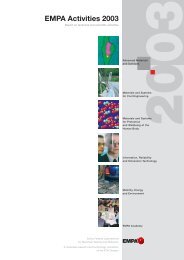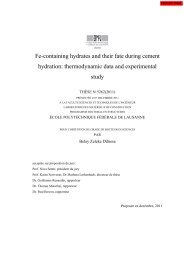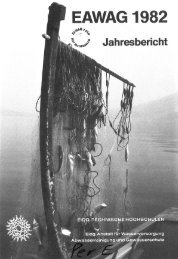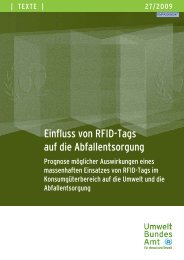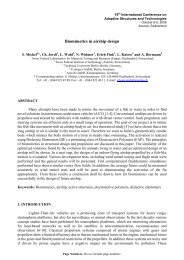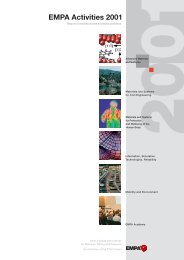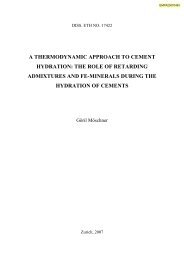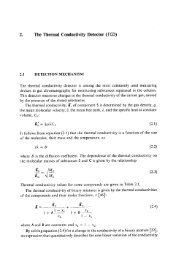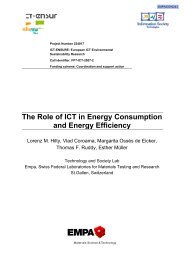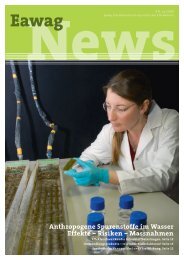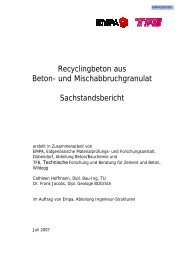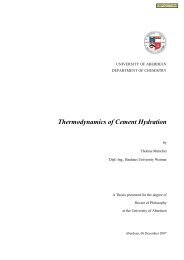Entire volume - Eawag
Entire volume - Eawag
Entire volume - Eawag
You also want an ePaper? Increase the reach of your titles
YUMPU automatically turns print PDFs into web optimized ePapers that Google loves.
Why Did a Cold Period Follow on<br />
the Heels of the Last Ice Age?<br />
Large-scale climate changes in the northern Atlantic region were<br />
often associated with changes in ocean currents. That is also the<br />
case for the last cold phase of the Würm Ice Age, known as the<br />
Younger Dryas. At this time, a new cold period occurred and the<br />
northern Atlantic region relapsed from a moderate climate back<br />
to glacial conditions in the course of just a few decades. Climate<br />
indicators provide nevertheless contradictory information concerning<br />
the origins of this cold phase. EAWAG is on the trail of additional<br />
clues in an ice core from Greenland.<br />
The Würm Ice Age is the most recent ice<br />
age in the course of earth’s history. It lasted<br />
approximately 100,000 years and ended<br />
only about 10,000 years ago. This ice age<br />
was characterized by rapid climate changes<br />
in the North Atlantic region. The last cold<br />
phase of the Würm Ice Age is known as<br />
the Younger Dryas. It started very suddenly<br />
about 12,700 years ago and lasted circa<br />
1200 years. In this period the mean annual<br />
temperature in Greenland fell by an amount<br />
on the order of 10 °C (Fig. 1A) [1]. A common<br />
hypothesis is that this climate change was<br />
caused by changes in the ocean currents. If<br />
the transport of warm water from the south<br />
to the north is interrupted, this would result<br />
in a sudden temperature fall in the northern<br />
regions. This hypothesis is supported by<br />
a number of observations. However, the<br />
The Radiocarbon Dating Method<br />
11 EAWAG news 58<br />
reconstruction of the atmospheric 14C provides<br />
contradictory evidence. EAWAG wanted<br />
to know more and pursued this contradiction.<br />
Contradictory Evidence<br />
The radioactive carbon isotope 14C (see<br />
box) is a natural trace element of enormous<br />
importance for climate research. It is produced<br />
continuously in the atmosphere by<br />
the action of cosmic radiation, and, after<br />
oxidation to 14CO2, takes part in the global<br />
carbon cycle.<br />
Oceans continuously exchange air and CO2, including radioactive 14C, with the atmosphere.<br />
Within the oceans the distribution<br />
of 14C is governed by oceanic ventilation:<br />
the better the oceans mix globally, the more<br />
14C is transported down to the deeper water<br />
Along with the two stable carbon isotopes, 12C and 13C, there is the radioactive isotope 14C. It<br />
has a half-life of 5730 years; i.e. after 5730 years half of the original 14C in any sample has decayed.<br />
This convenient fact is exploited in the 14C dating method. All living organisms continuously<br />
exchange 14C with their environment. This exchange stops when the organism dies. In the<br />
course of time, the radioactive 14C decays in the organism and the 14C concentration decreases<br />
continuously. By measuring the 14C concentration in a sample, it is therefore possible to estimate<br />
the age, or more precisely expressed, the point in time when the 14C exchange with the<br />
environment was interrupted.<br />
This is, however, only possible precisely when the history of the atmospheric 14C concentration<br />
is known. The reason is simple: if in the past the 14C concentration was higher, then it would<br />
have taken correspondingly longer for the decay to reduce 14C to a specific concentration. Without<br />
knowing the original 14C concentration in the air, one would draw the conclusion that the<br />
sample is younger than it actually is, or over-estimate its age in the opposite case.<br />
For this reason, scientists are developing a 14C calibration curve, which for the past 11,500 years<br />
was accurately dated within ±1 year [2]. This research involves above all fossil tree remains and<br />
sediments with known ages. The measurement of the 14C concentrations in individual tree rings<br />
and sediment layers can then be used to infer the past changes in the atmospheric 14C concentration.<br />
layers, and the more 14C poor water is transported<br />
from the deep sea to the surface.<br />
This process has the consequence that<br />
when ocean mixing is stronger the proportion<br />
of 14C in the atmosphere sinks. If we<br />
assume that the oceanic mixing in the North<br />
Atlantic during the Younger Dryas was in<br />
fact reduced, one would expect to see for<br />
this period, along with the above-described<br />
temperature fall, an accompanying increase<br />
in atmospheric 14C. By measuring the 14C concentration in sediments,<br />
it was possible to reconstruct the<br />
14C concentration in the atmosphere during<br />
the Younger Dryas [3]. As expected, the 14C concentration increased at the beginning<br />
of the Younger Dryas, which confirms the<br />
hypothesis of a reduced oceanic mixing.<br />
However, the 14C atmospheric concentration<br />
fell again long before it became significantly<br />
warmer in the North Atlantic (Fig. 1B).<br />
This contradicts the predicted association<br />
between heat transfer, deepwater formation<br />
and 14C content of the atmosphere. We<br />
wondered therefore what other factors<br />
could have played a role.<br />
Nuclide Production Effect<br />
on the 14C Concentration<br />
The 14C concentration in the atmosphere is<br />
not only determined by oceanic circulation,<br />
but is also influenced by the rate of production.<br />
During a period of weak solar activity,<br />
more 14C is produced in the atmosphere,<br />
which results in an increase in the atmospheric<br />
14C concentration. Such an increase<br />
in 14C occurred, for example, during the<br />
Maunder Minimum between 1645–1715 [4].




